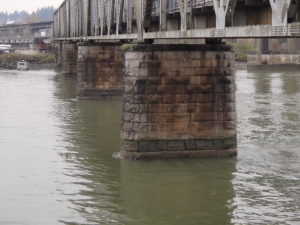Seismic Retrofit of a 110-year Old Railway Bridge
September 16, 2019 |
Canadian National Railway (CNR) operates a 110-year-old steel truss railway bridge which crosses the Fraser River, connecting the cities of New Westminster and Surrey, in the Metro Vancouver area in British Columbia, Canada. It is commonly known as the New Westminster Rail Bridge.
The main span of the bridge is supported by eleven piers made of unreinforced concrete, faced with granite blocks which support the superstructure truss spans. Pier 1 is on land (just off the photo in Figure 1), piers 2 to 5 are on deep concrete caissons, and piers 6 to 11 are on concrete-filled timber cribs with timber pile foundations installed by “jetting” into the river sands (Figure 2).


Seismic Retrofit Strategy
Although the bridge’s existing foundations have performed acceptably under static conditions for over 100 years, our analysis showed that the foundations would likely liquefy during a strong earthquake. This liquefaction, coupled with significant lateral spreading of the foundation soils over the river banks and along the riverbed, could result in excessive horizontal displacements of the piers, and structural failure of the bridge.
Replacing the bridge was not practical or cost-effective, so we developed a retrofit strategy to transfer the load of the bridge from the liquefiable foundation to a deeper non-liquefiable foundation, to withstand a 475-year return period earthquake. The most practical solution was to drive large diameter pipe piles upstream and downstream of piers 6 to 10, through the liquefiable layers to glacial till (Figure 3), and to connect the piles to the piers with steel collar frames.
We also considered methods to improve the strength of the potentially liquefiable foundation (i.e. ground improvement) around each of the piers and concluded that this was only practical at pier 11, where the ground surface is above river level. Ground improvement at piers 6 to 10 was not practical because of the required depth of pile driving, the large zone of riprap around the piers, and its impact on the environment and the river’s navigable channel.
Our solution meant that the existing foundations would continue to support the piers under static conditions, while the retrofitted piers 6 to 11 would limit the horizontal movements of the piers and bear the weight of the bridge during and after a strong earthquake.

Site Characteristics and Liquefaction Assessment
The foundation soils of the bridge consist predominantly of very dense glacial till overlain by clayey silt and river deposits. The river deposits are interbedded sands and silts of varying densities, identified as “potentially liquefiable soil” in Figure 3. The liquefaction assessment of the river deposits assumed a design earthquake with a 10% probability of exceedance in 50 years, i.e. a 475-year return period.
Seismic Deformation Analysis
We used the finite difference program FLAC and effective stress-based constitutive model UBCSAND to evaluate the dynamic response of the bridge’s foundation soils and the retrofit piles (at the soil-pile interface) at piers 6-11. Results from the FLAC analysis showed the predicted maximum pile head displacements, during a strong earthquake, can be accommodated by replacing the existing bridge bearings with new sliding-plate bearings.
Construction is currently underway on the bridge’s seismic retrofit. The New Westminster Rail Bridge is a key transportation link in the gateway to Canada’s most important port in Vancouver. This work will dramatically improve the structure’s ability to withstand a major earthquake.
